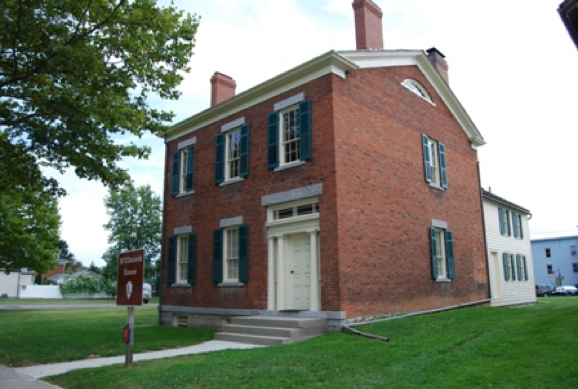It’s All About the Aesthetics
By: Maria Smith
Hi Everyone!
I can’t believe that I didn’t give you all a preview to this blog post in my last one! I was just too excited about the wonderful Convention Days programming to remember! Today, I’m going to discuss the aesthetic choices that I’m making for the storymap. I will also be sharing a vignette (story) about Mary Ann M’Clintock.
Aesthetic Decisions
A successful storymap requires exceptional aesthetics. Despite what we were taught as kids, people judge storymaps by their cover. It is important to have great content within a storymap, but only a few people will read the great content if it is not displayed in a pretty package. So, I’m feeling the pressure to keep my storymap looking as pretty as possible.
I am using ArcGIS Online to create my storymap. They have different templates, features, and extras that help to make it easy to create a unique storymap. You can add different photos, maps, videos, text, and more to your storymap. So, there are many ways to create a great storymap, but there are also a lot of ways for you to create a poor storymap. My three main goals are 1) to create an aesthetically pleasing (a.k.a. pretty) storymap; 2) to create an organized storymap; 3) to create an informative storymap.
I have already accomplished my second and third goals. I found some rich information and many useful links during the research stage of my storymap. I plan to include the links within my storymap so that people can find more information on topics that interest them. I wrote an organized narrative for my storymap during my writing phase. There are a lot of moving pieces in this storymap, so it took a few tries, but the story now flows in an organized and logical manner.
I am now tackling my first goal. I am in the drafting stage of my storymap. I am working on ArcGIS to create an aesthetically pleasing storymap. Today, I have focused on two aesthetic dilemmas; the links and the photo credits.
There are two ways to include links for more information. I could either put “for more information: LINK,” or I could embed the link (see images). I aesthetically prefer the embedded link, but it also reminds me of ads in the cooking blogs that I read. I don’t want viewers to think that I included advertisements within my storymap.

Link Example with Link Embedded

Link Example with Link URL in Text
There are also two ways to include image credits. I can either put the credit on the image, or I can put the credit in an information icon (see images). This decision is harder for me than the decision about the link. I believe that image credits should be clear and obvious. No one should be searching for an image icon to find who owns the image. I also don’t want to detract from the image with a photo credit box. I ultimately think that I will include the photo credit box, but I am still seeking other opinions on this decision.

Example of Photo Credit Icon

Example of Photo Credit on Image
A Vignette of Mary Ann M’Clintock

Mary Ann M’Clintock Photo Credit: Library of Congress
Mary Ann Wilson M’Clintock was a Philadelphia Quaker. The Philadelphia Quaker community was actively involved in social reform movements. In particular, M’Clintock was involved in the abolitionist movement. She was a co-founder of the mixed-race abolitionist group, the Philadelphia Female Anti-Slavery Society. M’Clintock’s activist work is a significant part of U.S. and women’s history. However, for this vignette, I am going to focus on her wedding.
Mary Ann married her husband, Thomas, in 1820. Thomas M’Clintock was also an active abolitionist and Quaker in Philadelphia. He owned an apothecary in Philadelphia, where he was raising his orphaned niece and nephew. Mary Ann and Thomas had a Quaker wedding ceremony that highlighted Quaker beliefs in gender equality. Before the couple could get married in the Quaker faith, both of their Quaker meetings (a congregation of Quakers) had to agree to their marriage. Once both meetings provided their blessing, Mary Ann and Thomas had their ceremony. Mary Ann was not given away by her father. Instead, she walked down the aisle by herself. She and Thomas officiated their own wedding. In the Quaker faith, marriage is between the couple and God, so there is not a need for an officiant.
The M’Clintocks continued to live in an equitable home. This undoubtedly influenced their daughters. The M’Clintock’s eldest daughter, Elizabeth, was a well-known women’s rights activist. She became known for her wit and humor in her defense of women’s rights. Elizabeth M’Clintock once wrote a satirical drama about Lucretia Mott’s son-in-law, after he refused to hire her and a friend for a men’s apprentice position at his shop. Mott found the drama delightful.

The M’Clintock House Photo Credit: National Parks Service
Want to know more about the M’Clintocks? Find more information here:
https://www.youtube.com/watch?v=amp3DZlzork&t=2s
https://www.youtube.com/watch?v=owhUOPhxu-E
https://www.nps.gov/wori/learn/historyculture/mclintock-house.htm
Or plan your trip to the M’Clintock Home in Waterloo, NY to learn about the M’Clintocks from park rangers:
https://www.nps.gov/wori/planyourvisit/index.htm
